Strategic Analysis of Unilever: Global Strategies and Market Position
VerifiedAdded on 2023/06/10
|21
|4874
|237
Report
AI Summary
This report provides a comprehensive analysis of Unilever's strategic management, focusing on its global market position and key strategies. It examines Unilever's capital acquisition plans, merger and acquisition strategies, and marketing approaches, highlighting their influence on the company's competitive strength. The report also assesses Unilever's position relative to competitors like P&G and Nestle, emphasizing the importance of its diverse product umbrella. Furthermore, it proposes strategic options for Unilever, including expanding its product umbrella and supplying raw materials to competitors, to enhance its global presence and market control. Desklib offers a wealth of similar resources, including past papers and solved assignments, to aid students in their studies.
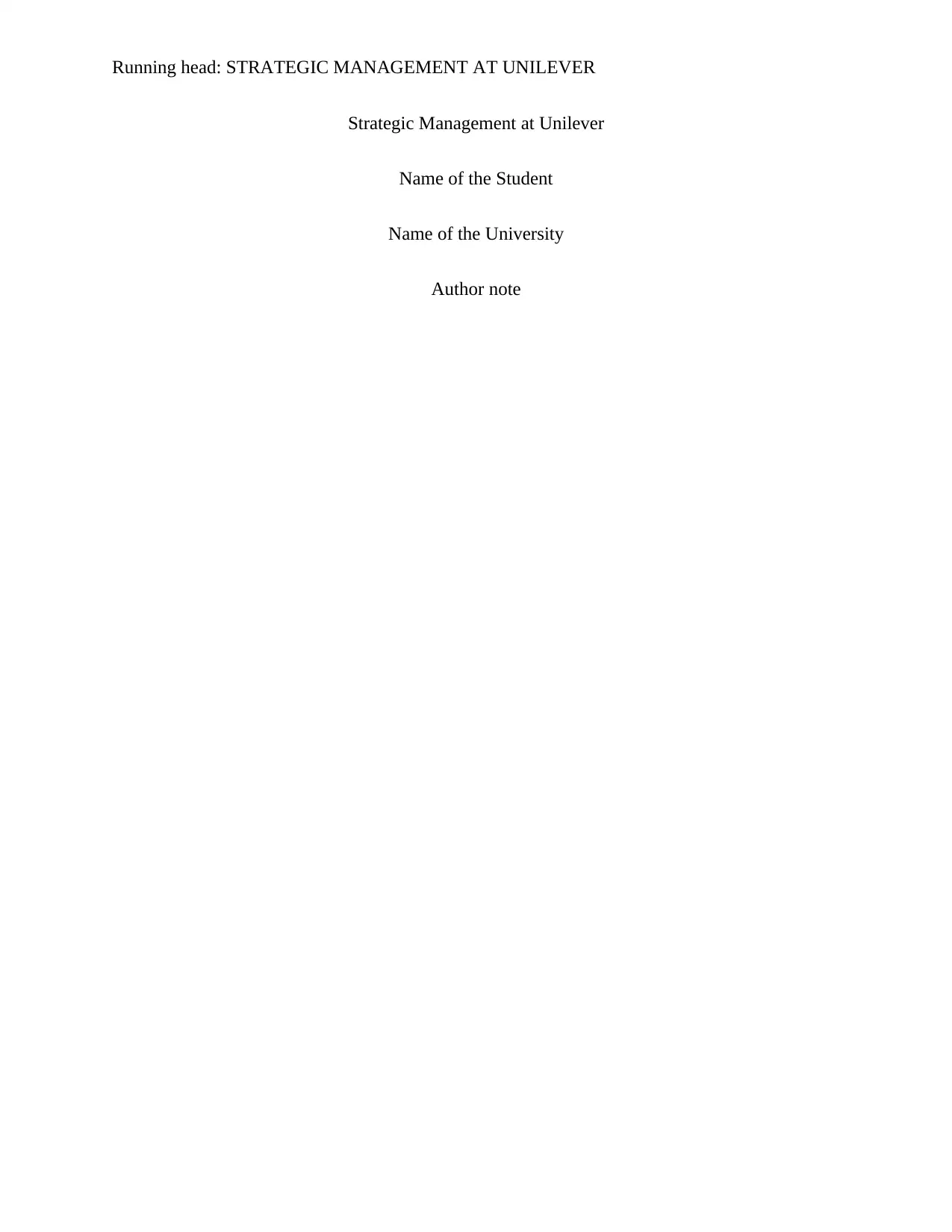
Running head: STRATEGIC MANAGEMENT AT UNILEVER
Strategic Management at Unilever
Name of the Student
Name of the University
Author note
Strategic Management at Unilever
Name of the Student
Name of the University
Author note
Paraphrase This Document
Need a fresh take? Get an instant paraphrase of this document with our AI Paraphraser
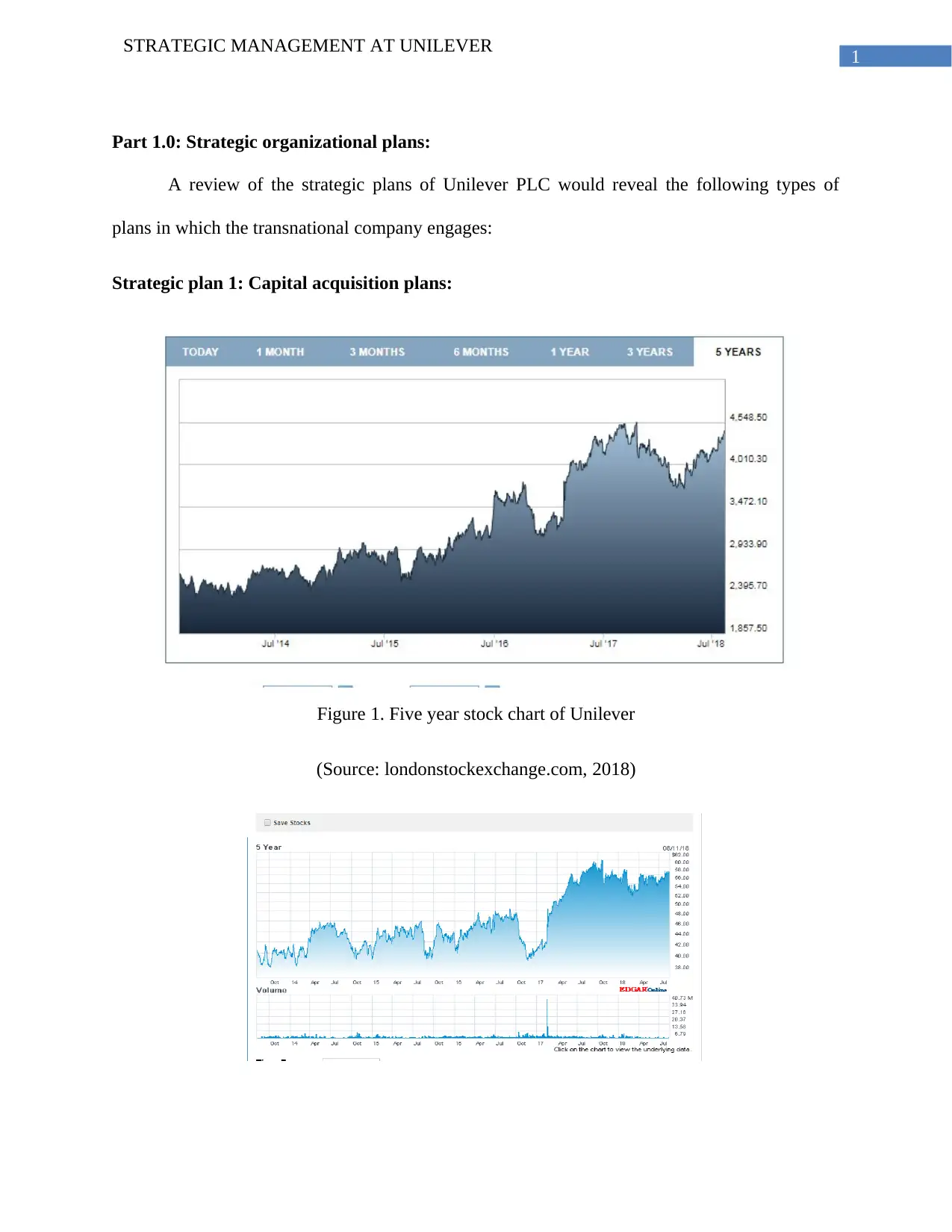
1
STRATEGIC MANAGEMENT AT UNILEVER
Part 1.0: Strategic organizational plans:
A review of the strategic plans of Unilever PLC would reveal the following types of
plans in which the transnational company engages:
Strategic plan 1: Capital acquisition plans:
Figure 1. Five year stock chart of Unilever
(Source: londonstockexchange.com, 2018)
STRATEGIC MANAGEMENT AT UNILEVER
Part 1.0: Strategic organizational plans:
A review of the strategic plans of Unilever PLC would reveal the following types of
plans in which the transnational company engages:
Strategic plan 1: Capital acquisition plans:
Figure 1. Five year stock chart of Unilever
(Source: londonstockexchange.com, 2018)

2
STRATEGIC MANAGEMENT AT UNILEVER
Figure 2. Stock price of Unilever on NASDAQ
(Source: nasdaq.com, 2018)
.
Figure 3. Unilever stock price on Boerse Stuttgart, Germany
(Source: boerse-stuttgart.de, 2018)
The first strategic plan of Unilever is its robust capital acquisition plan, which supports
all the subsequent strategic plan. The analysis of the operations of Unilever would show that the
public limited company owns some of the world’s top consumer brands and operates in more
than a hundred countries. Quality is one of the main attributes of the products Unilever
manufactures and the company employs more than a lakh employees globally. This clearly
points out that Unilever requires immense capital to support its massive business operations. The
company has its primary listing on the London Stock Exchange since its headquarters is in
London (Figure 1). The company is present in several host countries like the United States and
Germany through subsidiary companies which are also public limited companies. These public
STRATEGIC MANAGEMENT AT UNILEVER
Figure 2. Stock price of Unilever on NASDAQ
(Source: nasdaq.com, 2018)
.
Figure 3. Unilever stock price on Boerse Stuttgart, Germany
(Source: boerse-stuttgart.de, 2018)
The first strategic plan of Unilever is its robust capital acquisition plan, which supports
all the subsequent strategic plan. The analysis of the operations of Unilever would show that the
public limited company owns some of the world’s top consumer brands and operates in more
than a hundred countries. Quality is one of the main attributes of the products Unilever
manufactures and the company employs more than a lakh employees globally. This clearly
points out that Unilever requires immense capital to support its massive business operations. The
company has its primary listing on the London Stock Exchange since its headquarters is in
London (Figure 1). The company is present in several host countries like the United States and
Germany through subsidiary companies which are also public limited companies. These public
⊘ This is a preview!⊘
Do you want full access?
Subscribe today to unlock all pages.

Trusted by 1+ million students worldwide
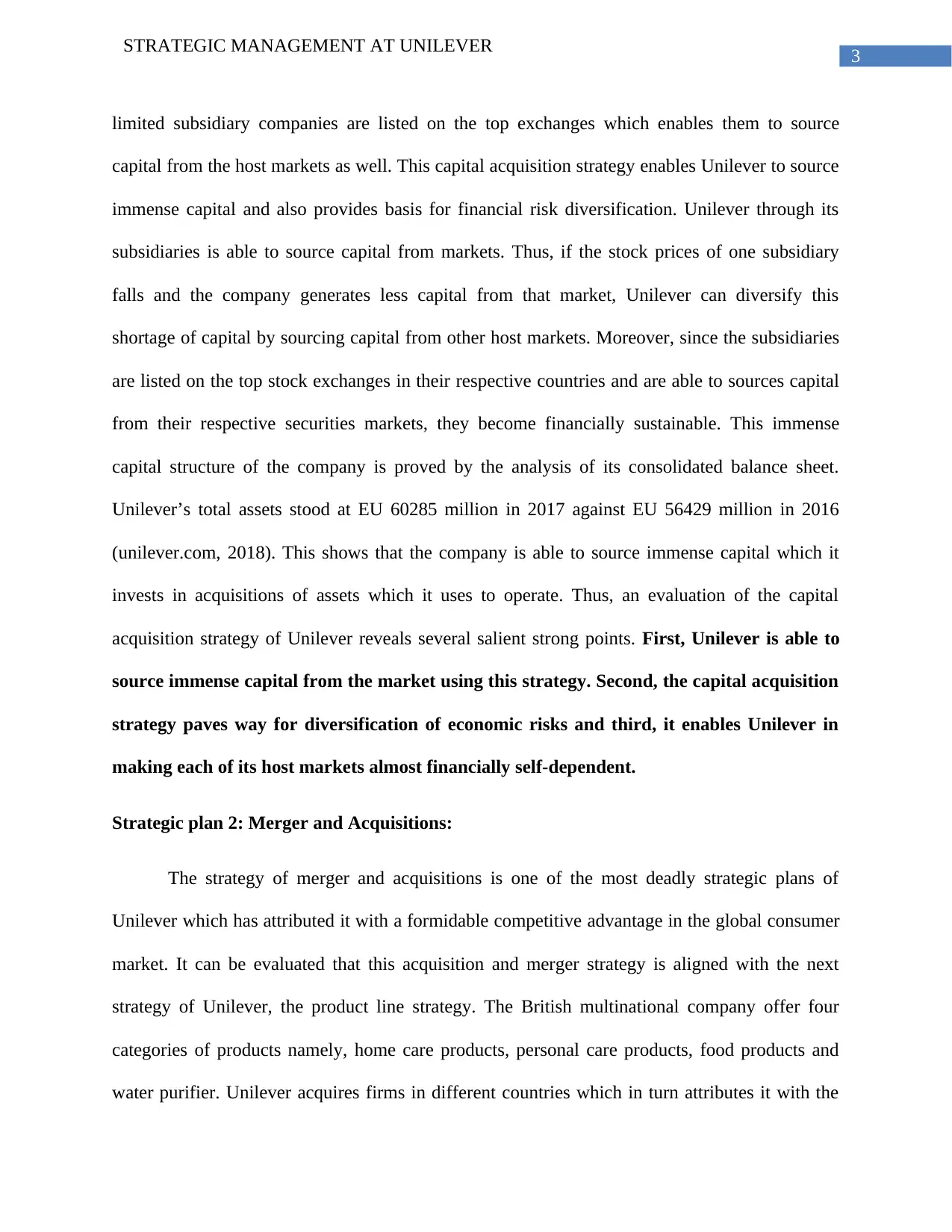
3
STRATEGIC MANAGEMENT AT UNILEVER
limited subsidiary companies are listed on the top exchanges which enables them to source
capital from the host markets as well. This capital acquisition strategy enables Unilever to source
immense capital and also provides basis for financial risk diversification. Unilever through its
subsidiaries is able to source capital from markets. Thus, if the stock prices of one subsidiary
falls and the company generates less capital from that market, Unilever can diversify this
shortage of capital by sourcing capital from other host markets. Moreover, since the subsidiaries
are listed on the top stock exchanges in their respective countries and are able to sources capital
from their respective securities markets, they become financially sustainable. This immense
capital structure of the company is proved by the analysis of its consolidated balance sheet.
Unilever’s total assets stood at EU 60285 million in 2017 against EU 56429 million in 2016
(unilever.com, 2018). This shows that the company is able to source immense capital which it
invests in acquisitions of assets which it uses to operate. Thus, an evaluation of the capital
acquisition strategy of Unilever reveals several salient strong points. First, Unilever is able to
source immense capital from the market using this strategy. Second, the capital acquisition
strategy paves way for diversification of economic risks and third, it enables Unilever in
making each of its host markets almost financially self-dependent.
Strategic plan 2: Merger and Acquisitions:
The strategy of merger and acquisitions is one of the most deadly strategic plans of
Unilever which has attributed it with a formidable competitive advantage in the global consumer
market. It can be evaluated that this acquisition and merger strategy is aligned with the next
strategy of Unilever, the product line strategy. The British multinational company offer four
categories of products namely, home care products, personal care products, food products and
water purifier. Unilever acquires firms in different countries which in turn attributes it with the
STRATEGIC MANAGEMENT AT UNILEVER
limited subsidiary companies are listed on the top exchanges which enables them to source
capital from the host markets as well. This capital acquisition strategy enables Unilever to source
immense capital and also provides basis for financial risk diversification. Unilever through its
subsidiaries is able to source capital from markets. Thus, if the stock prices of one subsidiary
falls and the company generates less capital from that market, Unilever can diversify this
shortage of capital by sourcing capital from other host markets. Moreover, since the subsidiaries
are listed on the top stock exchanges in their respective countries and are able to sources capital
from their respective securities markets, they become financially sustainable. This immense
capital structure of the company is proved by the analysis of its consolidated balance sheet.
Unilever’s total assets stood at EU 60285 million in 2017 against EU 56429 million in 2016
(unilever.com, 2018). This shows that the company is able to source immense capital which it
invests in acquisitions of assets which it uses to operate. Thus, an evaluation of the capital
acquisition strategy of Unilever reveals several salient strong points. First, Unilever is able to
source immense capital from the market using this strategy. Second, the capital acquisition
strategy paves way for diversification of economic risks and third, it enables Unilever in
making each of its host markets almost financially self-dependent.
Strategic plan 2: Merger and Acquisitions:
The strategy of merger and acquisitions is one of the most deadly strategic plans of
Unilever which has attributed it with a formidable competitive advantage in the global consumer
market. It can be evaluated that this acquisition and merger strategy is aligned with the next
strategy of Unilever, the product line strategy. The British multinational company offer four
categories of products namely, home care products, personal care products, food products and
water purifier. Unilever acquires firms in different countries which in turn attributes it with the
Paraphrase This Document
Need a fresh take? Get an instant paraphrase of this document with our AI Paraphraser
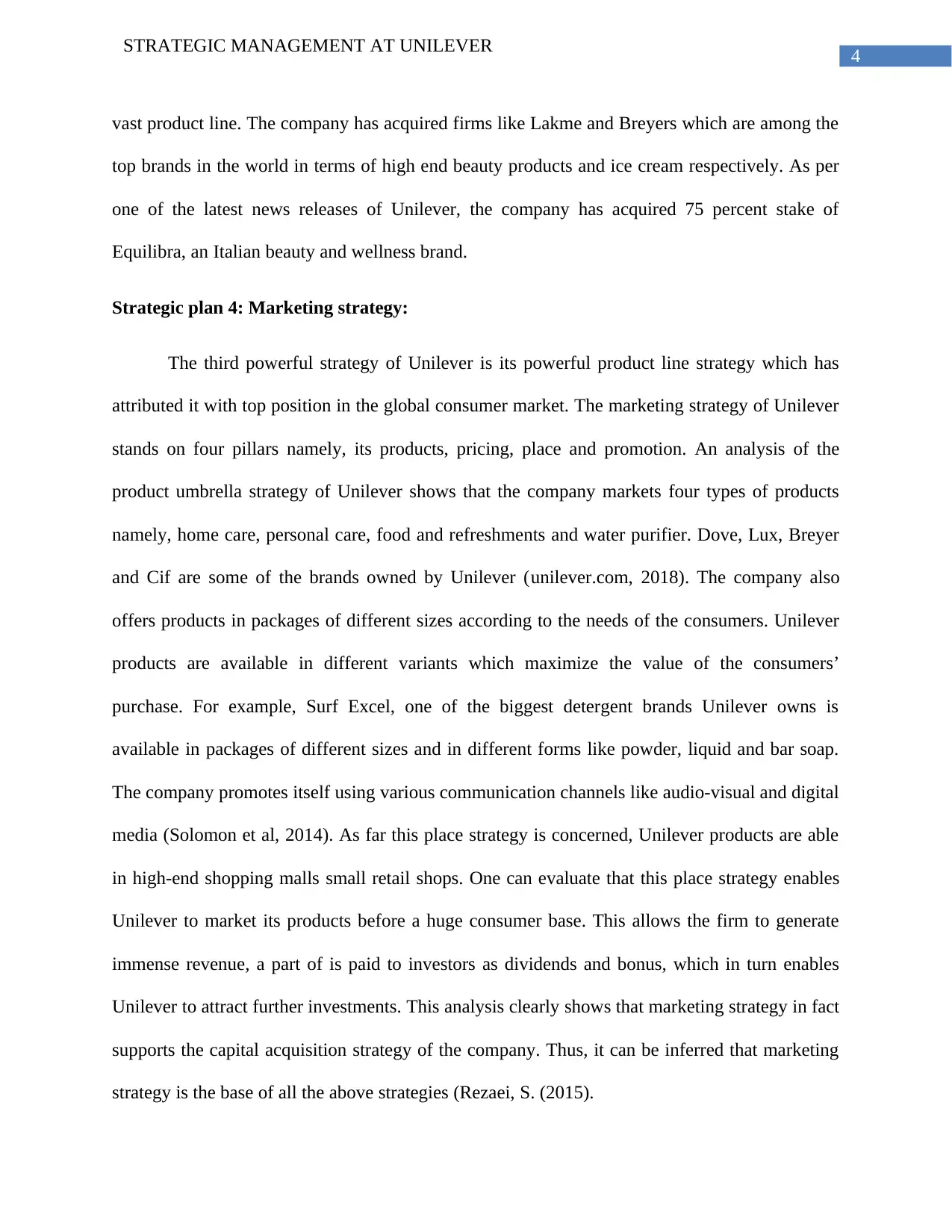
4
STRATEGIC MANAGEMENT AT UNILEVER
vast product line. The company has acquired firms like Lakme and Breyers which are among the
top brands in the world in terms of high end beauty products and ice cream respectively. As per
one of the latest news releases of Unilever, the company has acquired 75 percent stake of
Equilibra, an Italian beauty and wellness brand.
Strategic plan 4: Marketing strategy:
The third powerful strategy of Unilever is its powerful product line strategy which has
attributed it with top position in the global consumer market. The marketing strategy of Unilever
stands on four pillars namely, its products, pricing, place and promotion. An analysis of the
product umbrella strategy of Unilever shows that the company markets four types of products
namely, home care, personal care, food and refreshments and water purifier. Dove, Lux, Breyer
and Cif are some of the brands owned by Unilever (unilever.com, 2018). The company also
offers products in packages of different sizes according to the needs of the consumers. Unilever
products are available in different variants which maximize the value of the consumers’
purchase. For example, Surf Excel, one of the biggest detergent brands Unilever owns is
available in packages of different sizes and in different forms like powder, liquid and bar soap.
The company promotes itself using various communication channels like audio-visual and digital
media (Solomon et al, 2014). As far this place strategy is concerned, Unilever products are able
in high-end shopping malls small retail shops. One can evaluate that this place strategy enables
Unilever to market its products before a huge consumer base. This allows the firm to generate
immense revenue, a part of is paid to investors as dividends and bonus, which in turn enables
Unilever to attract further investments. This analysis clearly shows that marketing strategy in fact
supports the capital acquisition strategy of the company. Thus, it can be inferred that marketing
strategy is the base of all the above strategies (Rezaei, S. (2015).
STRATEGIC MANAGEMENT AT UNILEVER
vast product line. The company has acquired firms like Lakme and Breyers which are among the
top brands in the world in terms of high end beauty products and ice cream respectively. As per
one of the latest news releases of Unilever, the company has acquired 75 percent stake of
Equilibra, an Italian beauty and wellness brand.
Strategic plan 4: Marketing strategy:
The third powerful strategy of Unilever is its powerful product line strategy which has
attributed it with top position in the global consumer market. The marketing strategy of Unilever
stands on four pillars namely, its products, pricing, place and promotion. An analysis of the
product umbrella strategy of Unilever shows that the company markets four types of products
namely, home care, personal care, food and refreshments and water purifier. Dove, Lux, Breyer
and Cif are some of the brands owned by Unilever (unilever.com, 2018). The company also
offers products in packages of different sizes according to the needs of the consumers. Unilever
products are available in different variants which maximize the value of the consumers’
purchase. For example, Surf Excel, one of the biggest detergent brands Unilever owns is
available in packages of different sizes and in different forms like powder, liquid and bar soap.
The company promotes itself using various communication channels like audio-visual and digital
media (Solomon et al, 2014). As far this place strategy is concerned, Unilever products are able
in high-end shopping malls small retail shops. One can evaluate that this place strategy enables
Unilever to market its products before a huge consumer base. This allows the firm to generate
immense revenue, a part of is paid to investors as dividends and bonus, which in turn enables
Unilever to attract further investments. This analysis clearly shows that marketing strategy in fact
supports the capital acquisition strategy of the company. Thus, it can be inferred that marketing
strategy is the base of all the above strategies (Rezaei, S. (2015).
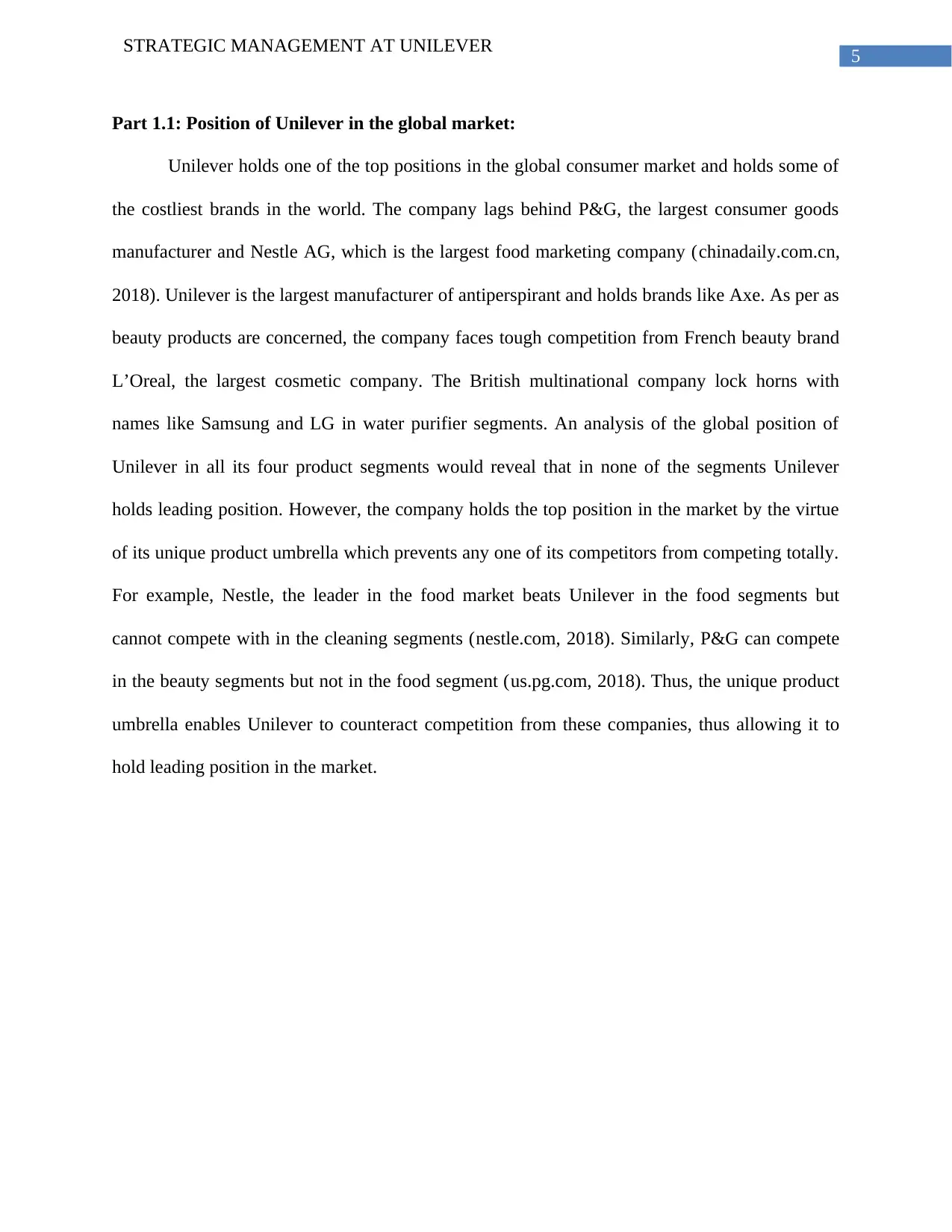
5
STRATEGIC MANAGEMENT AT UNILEVER
Part 1.1: Position of Unilever in the global market:
Unilever holds one of the top positions in the global consumer market and holds some of
the costliest brands in the world. The company lags behind P&G, the largest consumer goods
manufacturer and Nestle AG, which is the largest food marketing company (chinadaily.com.cn,
2018). Unilever is the largest manufacturer of antiperspirant and holds brands like Axe. As per as
beauty products are concerned, the company faces tough competition from French beauty brand
L’Oreal, the largest cosmetic company. The British multinational company lock horns with
names like Samsung and LG in water purifier segments. An analysis of the global position of
Unilever in all its four product segments would reveal that in none of the segments Unilever
holds leading position. However, the company holds the top position in the market by the virtue
of its unique product umbrella which prevents any one of its competitors from competing totally.
For example, Nestle, the leader in the food market beats Unilever in the food segments but
cannot compete with in the cleaning segments (nestle.com, 2018). Similarly, P&G can compete
in the beauty segments but not in the food segment (us.pg.com, 2018). Thus, the unique product
umbrella enables Unilever to counteract competition from these companies, thus allowing it to
hold leading position in the market.
STRATEGIC MANAGEMENT AT UNILEVER
Part 1.1: Position of Unilever in the global market:
Unilever holds one of the top positions in the global consumer market and holds some of
the costliest brands in the world. The company lags behind P&G, the largest consumer goods
manufacturer and Nestle AG, which is the largest food marketing company (chinadaily.com.cn,
2018). Unilever is the largest manufacturer of antiperspirant and holds brands like Axe. As per as
beauty products are concerned, the company faces tough competition from French beauty brand
L’Oreal, the largest cosmetic company. The British multinational company lock horns with
names like Samsung and LG in water purifier segments. An analysis of the global position of
Unilever in all its four product segments would reveal that in none of the segments Unilever
holds leading position. However, the company holds the top position in the market by the virtue
of its unique product umbrella which prevents any one of its competitors from competing totally.
For example, Nestle, the leader in the food market beats Unilever in the food segments but
cannot compete with in the cleaning segments (nestle.com, 2018). Similarly, P&G can compete
in the beauty segments but not in the food segment (us.pg.com, 2018). Thus, the unique product
umbrella enables Unilever to counteract competition from these companies, thus allowing it to
hold leading position in the market.
⊘ This is a preview!⊘
Do you want full access?
Subscribe today to unlock all pages.

Trusted by 1+ million students worldwide

6
STRATEGIC MANAGEMENT AT UNILEVER
Unilever
product
umbrella
Food and
refreshments
Home care Personal care Water purifier
Brands of
Unilever
Knorr, Magnum,
Bru, Lipton etc
OMO, Domex,
Cif
Dove, Lux, Axe,
Lakme
Pureit
Nestle Nescafe, Maggi NA NA NA
L’Oreal NA NA L’Oreal products NA
P&G NA Tide, Ambi Pur,,
Ariel
Pentene, Head &
shoulders, Olay,
Gillette
NA
Samsung, LG NA NA NA Water purifier
Figure 4. Table shwoing competitors of Unilever
(Source:Author)
Part 1.2: Influence of existing plans of Unilever on itself:
Influence of capital acquisition plan:
The capital acquisition plan of Unilever has several positive influences on the company.
Unilever along through its subsidiaries in charge of the respective host markets is listed on
several top stock exchanges. The company, thus is able to float shares in the stock market to
raise colossal amount of capital. First, this capital attributes Unilever with a strong financial base
and enable it to carry on business operations in the international market. The immense capital
base enables Unilever to conduct continuous research and development which is the second
STRATEGIC MANAGEMENT AT UNILEVER
Unilever
product
umbrella
Food and
refreshments
Home care Personal care Water purifier
Brands of
Unilever
Knorr, Magnum,
Bru, Lipton etc
OMO, Domex,
Cif
Dove, Lux, Axe,
Lakme
Pureit
Nestle Nescafe, Maggi NA NA NA
L’Oreal NA NA L’Oreal products NA
P&G NA Tide, Ambi Pur,,
Ariel
Pentene, Head &
shoulders, Olay,
Gillette
NA
Samsung, LG NA NA NA Water purifier
Figure 4. Table shwoing competitors of Unilever
(Source:Author)
Part 1.2: Influence of existing plans of Unilever on itself:
Influence of capital acquisition plan:
The capital acquisition plan of Unilever has several positive influences on the company.
Unilever along through its subsidiaries in charge of the respective host markets is listed on
several top stock exchanges. The company, thus is able to float shares in the stock market to
raise colossal amount of capital. First, this capital attributes Unilever with a strong financial base
and enable it to carry on business operations in the international market. The immense capital
base enables Unilever to conduct continuous research and development which is the second
Paraphrase This Document
Need a fresh take? Get an instant paraphrase of this document with our AI Paraphraser
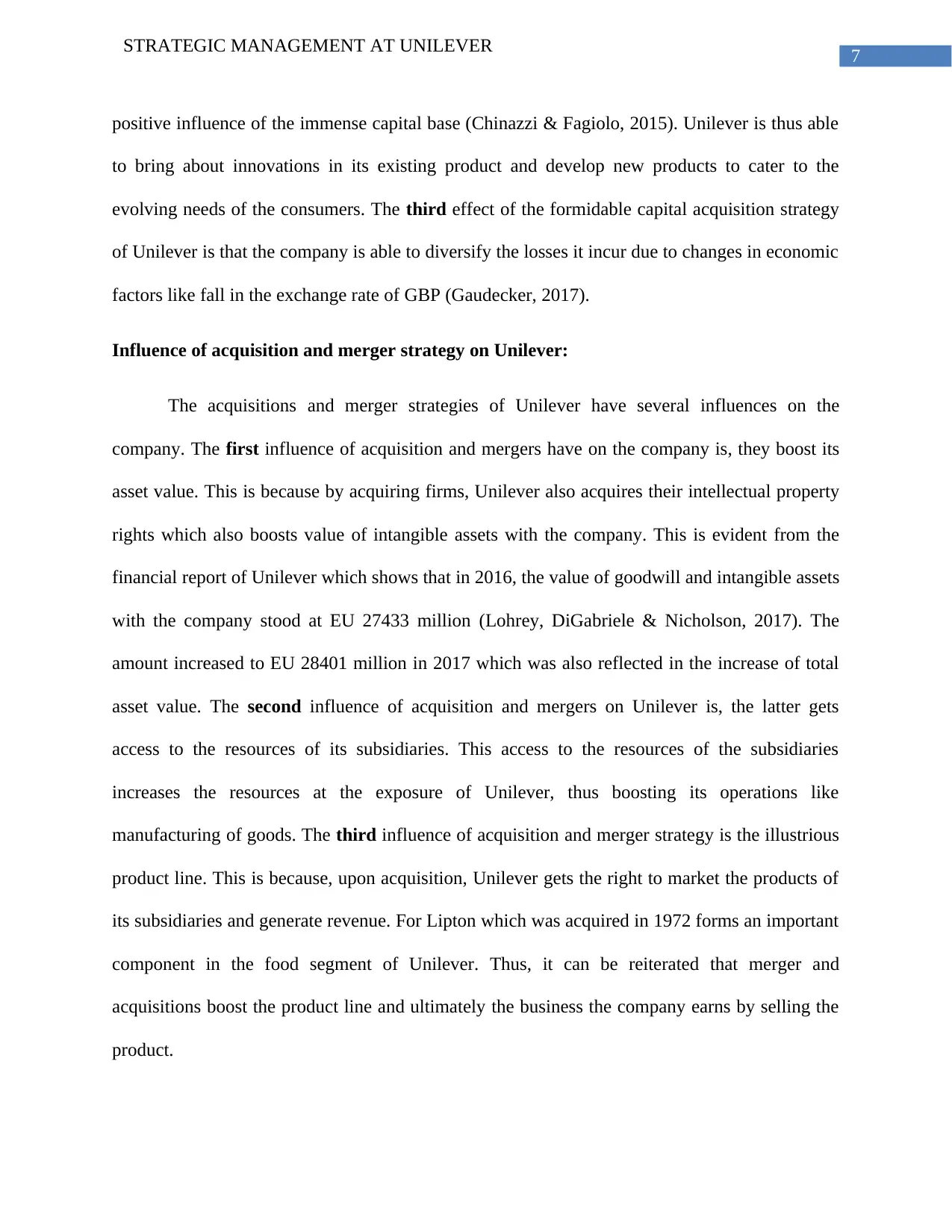
7
STRATEGIC MANAGEMENT AT UNILEVER
positive influence of the immense capital base (Chinazzi & Fagiolo, 2015). Unilever is thus able
to bring about innovations in its existing product and develop new products to cater to the
evolving needs of the consumers. The third effect of the formidable capital acquisition strategy
of Unilever is that the company is able to diversify the losses it incur due to changes in economic
factors like fall in the exchange rate of GBP (Gaudecker, 2017).
Influence of acquisition and merger strategy on Unilever:
The acquisitions and merger strategies of Unilever have several influences on the
company. The first influence of acquisition and mergers have on the company is, they boost its
asset value. This is because by acquiring firms, Unilever also acquires their intellectual property
rights which also boosts value of intangible assets with the company. This is evident from the
financial report of Unilever which shows that in 2016, the value of goodwill and intangible assets
with the company stood at EU 27433 million (Lohrey, DiGabriele & Nicholson, 2017). The
amount increased to EU 28401 million in 2017 which was also reflected in the increase of total
asset value. The second influence of acquisition and mergers on Unilever is, the latter gets
access to the resources of its subsidiaries. This access to the resources of the subsidiaries
increases the resources at the exposure of Unilever, thus boosting its operations like
manufacturing of goods. The third influence of acquisition and merger strategy is the illustrious
product line. This is because, upon acquisition, Unilever gets the right to market the products of
its subsidiaries and generate revenue. For Lipton which was acquired in 1972 forms an important
component in the food segment of Unilever. Thus, it can be reiterated that merger and
acquisitions boost the product line and ultimately the business the company earns by selling the
product.
STRATEGIC MANAGEMENT AT UNILEVER
positive influence of the immense capital base (Chinazzi & Fagiolo, 2015). Unilever is thus able
to bring about innovations in its existing product and develop new products to cater to the
evolving needs of the consumers. The third effect of the formidable capital acquisition strategy
of Unilever is that the company is able to diversify the losses it incur due to changes in economic
factors like fall in the exchange rate of GBP (Gaudecker, 2017).
Influence of acquisition and merger strategy on Unilever:
The acquisitions and merger strategies of Unilever have several influences on the
company. The first influence of acquisition and mergers have on the company is, they boost its
asset value. This is because by acquiring firms, Unilever also acquires their intellectual property
rights which also boosts value of intangible assets with the company. This is evident from the
financial report of Unilever which shows that in 2016, the value of goodwill and intangible assets
with the company stood at EU 27433 million (Lohrey, DiGabriele & Nicholson, 2017). The
amount increased to EU 28401 million in 2017 which was also reflected in the increase of total
asset value. The second influence of acquisition and mergers on Unilever is, the latter gets
access to the resources of its subsidiaries. This access to the resources of the subsidiaries
increases the resources at the exposure of Unilever, thus boosting its operations like
manufacturing of goods. The third influence of acquisition and merger strategy is the illustrious
product line. This is because, upon acquisition, Unilever gets the right to market the products of
its subsidiaries and generate revenue. For Lipton which was acquired in 1972 forms an important
component in the food segment of Unilever. Thus, it can be reiterated that merger and
acquisitions boost the product line and ultimately the business the company earns by selling the
product.

8
STRATEGIC MANAGEMENT AT UNILEVER
Figure 5. Extract of balance sheet of Unilever
(Source: unilever.com, 2018)
Influence of marketing strategy on business of Unilever:
The first positive influence of marketing strategy of Unilever is that the company is able
to create immense demand for its products in the market. The company as a result is able to
generate huge sale from the sale of these products. This in turn generates immense revenue for
the Unilever and enables it to reinvest a portion of the revenue earned towards operations like
manufacturing of goods. Thus, it can be inferred from this analysis that the marketing strategy of
Unilever provides the company with a strong financial base. The third influence of the
aggressive marketing strategy of Unilever on the company itself is that, it renders Unilever with
STRATEGIC MANAGEMENT AT UNILEVER
Figure 5. Extract of balance sheet of Unilever
(Source: unilever.com, 2018)
Influence of marketing strategy on business of Unilever:
The first positive influence of marketing strategy of Unilever is that the company is able
to create immense demand for its products in the market. The company as a result is able to
generate huge sale from the sale of these products. This in turn generates immense revenue for
the Unilever and enables it to reinvest a portion of the revenue earned towards operations like
manufacturing of goods. Thus, it can be inferred from this analysis that the marketing strategy of
Unilever provides the company with a strong financial base. The third influence of the
aggressive marketing strategy of Unilever on the company itself is that, it renders Unilever with
⊘ This is a preview!⊘
Do you want full access?
Subscribe today to unlock all pages.

Trusted by 1+ million students worldwide
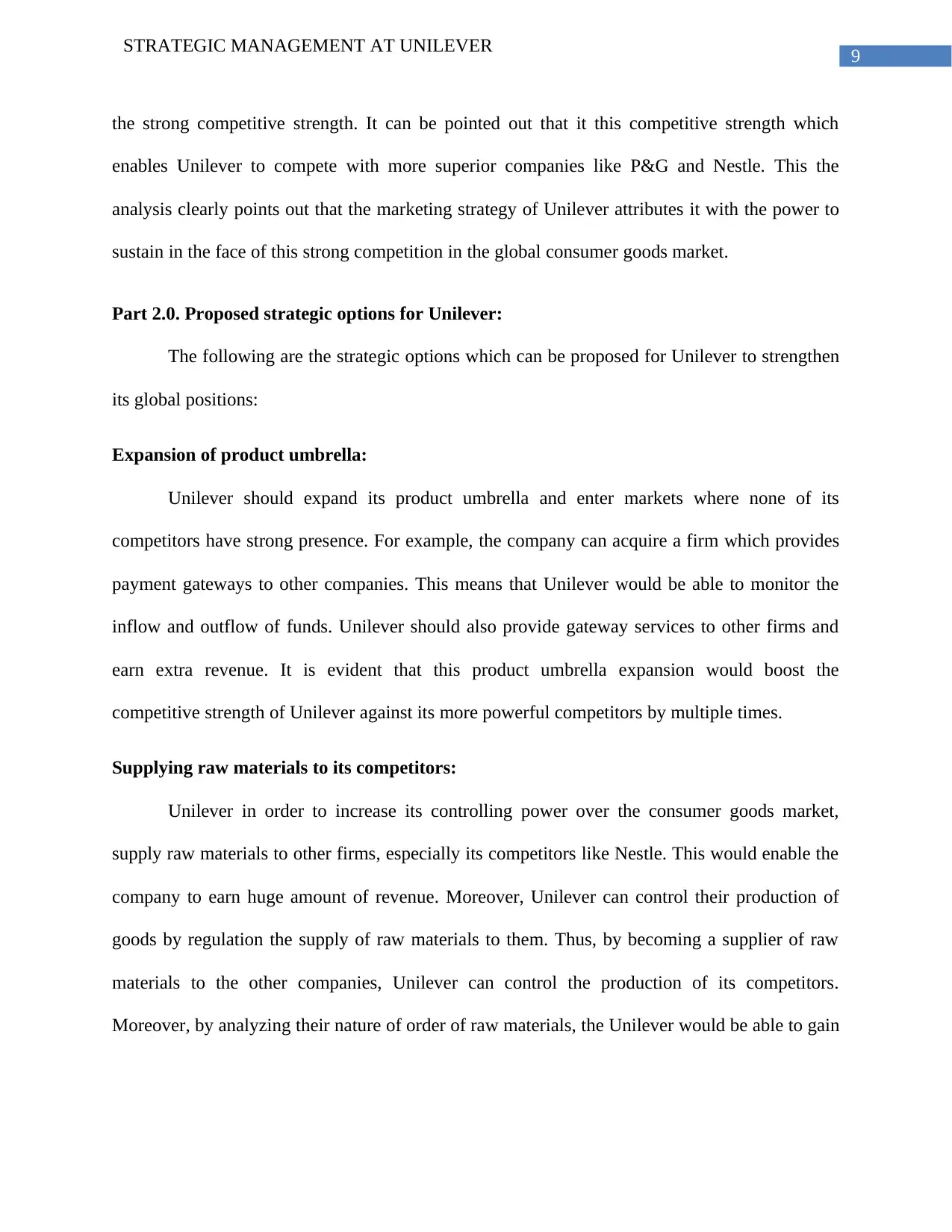
9
STRATEGIC MANAGEMENT AT UNILEVER
the strong competitive strength. It can be pointed out that it this competitive strength which
enables Unilever to compete with more superior companies like P&G and Nestle. This the
analysis clearly points out that the marketing strategy of Unilever attributes it with the power to
sustain in the face of this strong competition in the global consumer goods market.
Part 2.0. Proposed strategic options for Unilever:
The following are the strategic options which can be proposed for Unilever to strengthen
its global positions:
Expansion of product umbrella:
Unilever should expand its product umbrella and enter markets where none of its
competitors have strong presence. For example, the company can acquire a firm which provides
payment gateways to other companies. This means that Unilever would be able to monitor the
inflow and outflow of funds. Unilever should also provide gateway services to other firms and
earn extra revenue. It is evident that this product umbrella expansion would boost the
competitive strength of Unilever against its more powerful competitors by multiple times.
Supplying raw materials to its competitors:
Unilever in order to increase its controlling power over the consumer goods market,
supply raw materials to other firms, especially its competitors like Nestle. This would enable the
company to earn huge amount of revenue. Moreover, Unilever can control their production of
goods by regulation the supply of raw materials to them. Thus, by becoming a supplier of raw
materials to the other companies, Unilever can control the production of its competitors.
Moreover, by analyzing their nature of order of raw materials, the Unilever would be able to gain
STRATEGIC MANAGEMENT AT UNILEVER
the strong competitive strength. It can be pointed out that it this competitive strength which
enables Unilever to compete with more superior companies like P&G and Nestle. This the
analysis clearly points out that the marketing strategy of Unilever attributes it with the power to
sustain in the face of this strong competition in the global consumer goods market.
Part 2.0. Proposed strategic options for Unilever:
The following are the strategic options which can be proposed for Unilever to strengthen
its global positions:
Expansion of product umbrella:
Unilever should expand its product umbrella and enter markets where none of its
competitors have strong presence. For example, the company can acquire a firm which provides
payment gateways to other companies. This means that Unilever would be able to monitor the
inflow and outflow of funds. Unilever should also provide gateway services to other firms and
earn extra revenue. It is evident that this product umbrella expansion would boost the
competitive strength of Unilever against its more powerful competitors by multiple times.
Supplying raw materials to its competitors:
Unilever in order to increase its controlling power over the consumer goods market,
supply raw materials to other firms, especially its competitors like Nestle. This would enable the
company to earn huge amount of revenue. Moreover, Unilever can control their production of
goods by regulation the supply of raw materials to them. Thus, by becoming a supplier of raw
materials to the other companies, Unilever can control the production of its competitors.
Moreover, by analyzing their nature of order of raw materials, the Unilever would be able to gain
Paraphrase This Document
Need a fresh take? Get an instant paraphrase of this document with our AI Paraphraser

10
STRATEGIC MANAGEMENT AT UNILEVER
idea about their production. The company as a result would be able to form more formidable
business strategies which would contribute towards strengthening its competitive advantage
Part 2.1: Relationship between corporate, business and operational strategies:
Grayson and Hodges (2017) point out that corporate, business and operational strategies
are interrelated. For example, as far as Unilever in concerned, the apex management forms the
corporate strategies. They corporate strategies in turn contribute towards formation of strong
business strategies which in turn results in adoption of strong operational strategy. This analysis
shows that the three strategies are dependent on each other.
Part 2.2: Application of strategic models and tools to develop strategic options:
Strategic models and tools would enable Unilever to implement the two strategic options
discussed above and establish itself in them. The first strategic option is that Unilever must enter
new product markets. The second option is that Unilever should establish itself as a significant
supplier of raw materials to its competitors. It can be pointed out that both the markets are new to
the company and extremely competitive. Moreover, Unilever would have to allocate immense
funds in these two markets. This means that failure to establish itself in these markets would lead
to immense financial loss, thus effecting practically all the significant operations. Thus, in order
to prevent or minimize the risks which Unilever may face on implementing the two strategic
options, the company must use strategic tools and models. The tools can include PESTEL,
SWOT, balanced score card and strategy. The company can use tools like surveys to get more
in depth knowledge about the market. Application of these tools would enable the company to
enter the two new markets suggested above namely, payment gateways and raw materials.
STRATEGIC MANAGEMENT AT UNILEVER
idea about their production. The company as a result would be able to form more formidable
business strategies which would contribute towards strengthening its competitive advantage
Part 2.1: Relationship between corporate, business and operational strategies:
Grayson and Hodges (2017) point out that corporate, business and operational strategies
are interrelated. For example, as far as Unilever in concerned, the apex management forms the
corporate strategies. They corporate strategies in turn contribute towards formation of strong
business strategies which in turn results in adoption of strong operational strategy. This analysis
shows that the three strategies are dependent on each other.
Part 2.2: Application of strategic models and tools to develop strategic options:
Strategic models and tools would enable Unilever to implement the two strategic options
discussed above and establish itself in them. The first strategic option is that Unilever must enter
new product markets. The second option is that Unilever should establish itself as a significant
supplier of raw materials to its competitors. It can be pointed out that both the markets are new to
the company and extremely competitive. Moreover, Unilever would have to allocate immense
funds in these two markets. This means that failure to establish itself in these markets would lead
to immense financial loss, thus effecting practically all the significant operations. Thus, in order
to prevent or minimize the risks which Unilever may face on implementing the two strategic
options, the company must use strategic tools and models. The tools can include PESTEL,
SWOT, balanced score card and strategy. The company can use tools like surveys to get more
in depth knowledge about the market. Application of these tools would enable the company to
enter the two new markets suggested above namely, payment gateways and raw materials.
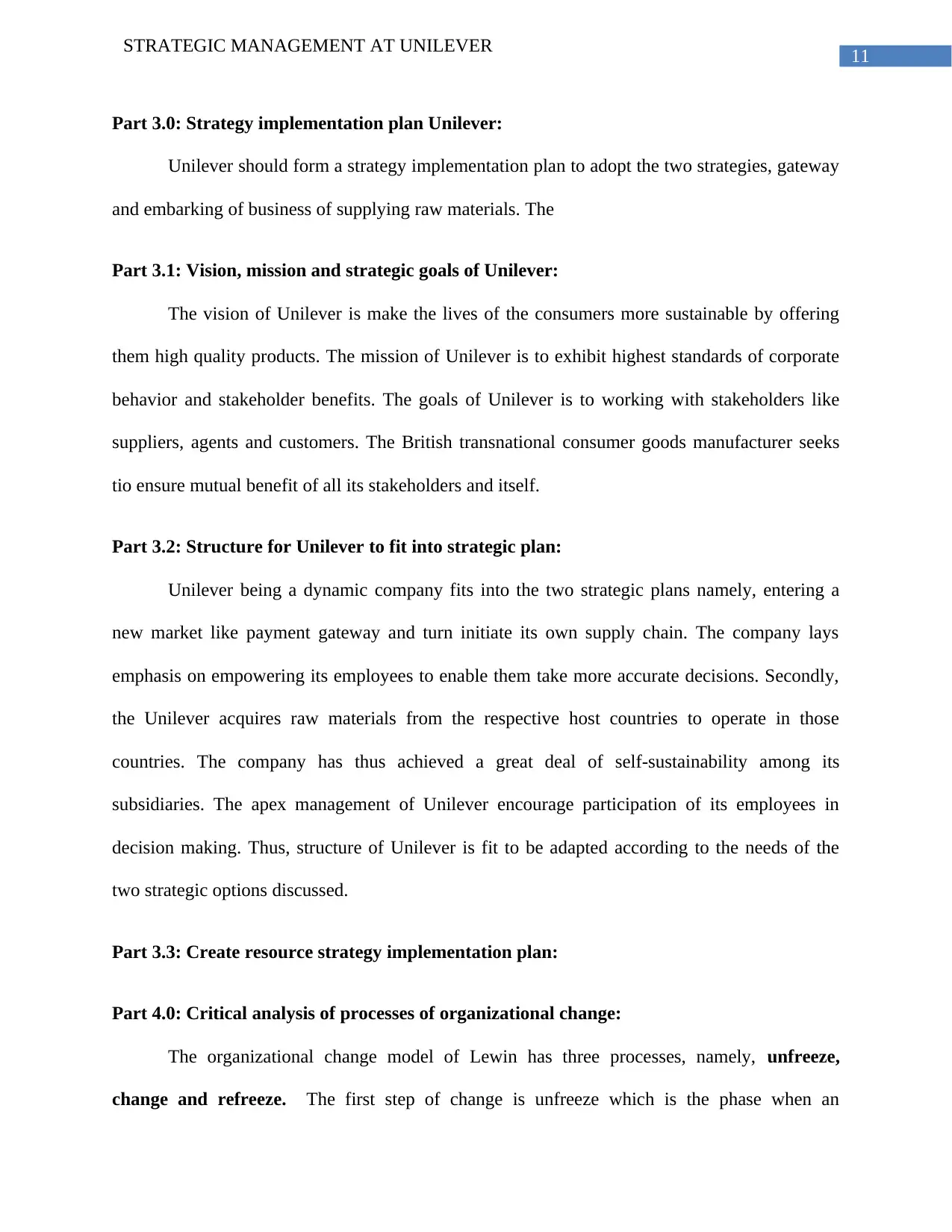
11
STRATEGIC MANAGEMENT AT UNILEVER
Part 3.0: Strategy implementation plan Unilever:
Unilever should form a strategy implementation plan to adopt the two strategies, gateway
and embarking of business of supplying raw materials. The
Part 3.1: Vision, mission and strategic goals of Unilever:
The vision of Unilever is make the lives of the consumers more sustainable by offering
them high quality products. The mission of Unilever is to exhibit highest standards of corporate
behavior and stakeholder benefits. The goals of Unilever is to working with stakeholders like
suppliers, agents and customers. The British transnational consumer goods manufacturer seeks
tio ensure mutual benefit of all its stakeholders and itself.
Part 3.2: Structure for Unilever to fit into strategic plan:
Unilever being a dynamic company fits into the two strategic plans namely, entering a
new market like payment gateway and turn initiate its own supply chain. The company lays
emphasis on empowering its employees to enable them take more accurate decisions. Secondly,
the Unilever acquires raw materials from the respective host countries to operate in those
countries. The company has thus achieved a great deal of self-sustainability among its
subsidiaries. The apex management of Unilever encourage participation of its employees in
decision making. Thus, structure of Unilever is fit to be adapted according to the needs of the
two strategic options discussed.
Part 3.3: Create resource strategy implementation plan:
Part 4.0: Critical analysis of processes of organizational change:
The organizational change model of Lewin has three processes, namely, unfreeze,
change and refreeze. The first step of change is unfreeze which is the phase when an
STRATEGIC MANAGEMENT AT UNILEVER
Part 3.0: Strategy implementation plan Unilever:
Unilever should form a strategy implementation plan to adopt the two strategies, gateway
and embarking of business of supplying raw materials. The
Part 3.1: Vision, mission and strategic goals of Unilever:
The vision of Unilever is make the lives of the consumers more sustainable by offering
them high quality products. The mission of Unilever is to exhibit highest standards of corporate
behavior and stakeholder benefits. The goals of Unilever is to working with stakeholders like
suppliers, agents and customers. The British transnational consumer goods manufacturer seeks
tio ensure mutual benefit of all its stakeholders and itself.
Part 3.2: Structure for Unilever to fit into strategic plan:
Unilever being a dynamic company fits into the two strategic plans namely, entering a
new market like payment gateway and turn initiate its own supply chain. The company lays
emphasis on empowering its employees to enable them take more accurate decisions. Secondly,
the Unilever acquires raw materials from the respective host countries to operate in those
countries. The company has thus achieved a great deal of self-sustainability among its
subsidiaries. The apex management of Unilever encourage participation of its employees in
decision making. Thus, structure of Unilever is fit to be adapted according to the needs of the
two strategic options discussed.
Part 3.3: Create resource strategy implementation plan:
Part 4.0: Critical analysis of processes of organizational change:
The organizational change model of Lewin has three processes, namely, unfreeze,
change and refreeze. The first step of change is unfreeze which is the phase when an
⊘ This is a preview!⊘
Do you want full access?
Subscribe today to unlock all pages.

Trusted by 1+ million students worldwide
1 out of 21
Related Documents
Your All-in-One AI-Powered Toolkit for Academic Success.
+13062052269
info@desklib.com
Available 24*7 on WhatsApp / Email
![[object Object]](/_next/static/media/star-bottom.7253800d.svg)
Unlock your academic potential
Copyright © 2020–2025 A2Z Services. All Rights Reserved. Developed and managed by ZUCOL.





